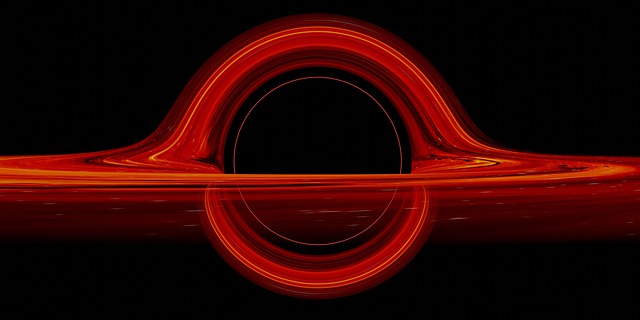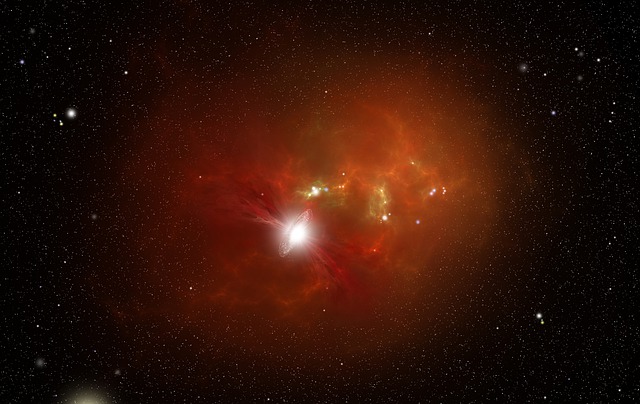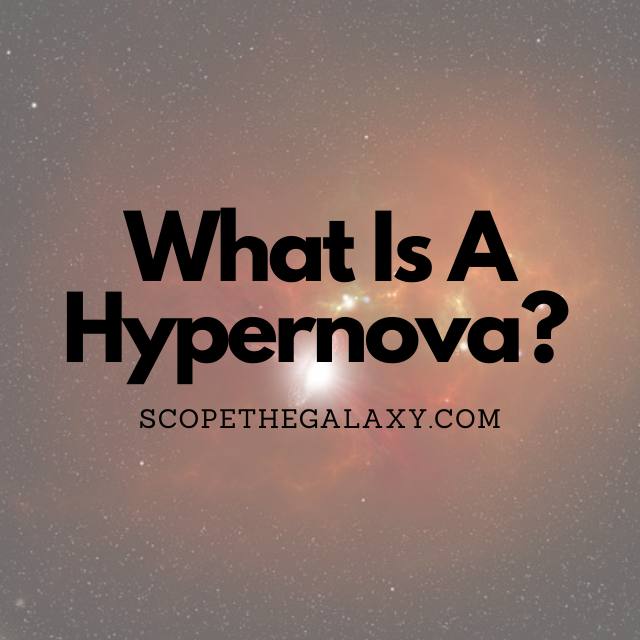*This post may contain affiliate links. This means we may make a commission if you purchase an item using one of our links*
A hypernova, also known as a collapsar, is a highly energetic supernova resulting from the core collapse of a massive star. While it is similar to a supernova, it is far more powerful and exudes much more light. The jets formed from a hypernova create gamma-ray bursts (GRBs), which could be responsible for mass extinction events.
Continue reading to discover how a hypernova occurs, what happens after the explosion, and just how powerful these impressive space events really are.
How Does A Hypernova Happen?
Table of Contents
A hypernova is a particular type of supernova that occurs when a massive star – one that has a mass 30 times greater than that of our own sun – collapses and forms a spinning black hole. This rotating body is surrounded by an accretion disc and two stellar jets traveling close to the speed of light.
When massive stars die, they form a dense core of iron and nickel. Unlike other, lighter elements, this iron fusion takes away energy rather than creating it. So with nothing to protect against the crushing weight of the star’s atmosphere, it begins a catastrophic collapse.
In its final few moments, the squashed core of these massive stars converts into a ball that is almost pure neutrons. This halts its collapse, momentarily triggering a bounce and then a supernova explosion. But the birth of this neutron star is short-lived as it folds in on itself (under the unfathomable pressure of gravity) and transforms into a black hole.

The collapsar model proposes the theory that these explosions could derive from the star’s heart itself. Within the core of these massive stellar bodies, elements fuse together in the form of radiation. This radiation pushes against the star’s outward forces, keeping everything balanced.
But when you combine an electron and a positron, you release a load of pure energy in the form of a gamma-ray. And this process can happen in reverse (a gamma separates into an electron and positron).
These reactions constantly occur within a massive star’s core, keeping it stable. But, if they fall out of balance – even a tiny bit – it could be enough to create a massive collapse.
Who Discovered Hypernovas?
In 1967, the US military detected GRBs while using satellites to search for gamma radiation from suspected nuclear weapons. Over the next few decades, these GRBs became a mystery to scientists who could not correlate them to solar flares, supernovas, or any other space activity. However, once astronomers determined their direction, we could see that these phenomena were not originating from our own galaxy but deep space.
In the 1980s, scientists used the term hypernova to describe a theoretical supernova that we now call a pair-instability supernova. Previously, astronomers used this term to describe the hypothetical explosions from hyper stars.
In 1997, BeppoSAX – a Dutch-Italian satellite – traced GRB 970508 to a galaxy around 6 billion light-years from our own. Following data analysis, Bloom et al. concluded that a hypernova was the likely cause of this phenomenon. And in the same year, Bohdan Paczynski hypothesized hypernovas in much greater detail.
One explosion in 1998 revolutionized our understanding of the relationship between a hypernova and GRBs. And when astronomers observed a hypernova spectrum within the spectrum of an optical transient, this connection was firmly established.
How Powerful Is A Hypernova?

A Hypernova is more powerful and rarer than a supernova – only occurring around five times in every one million years. A hypernova may be the most powerful explosion in our universe since the Big Bang; they are between 10 and 100 times brighter than the average supernova.
They carry enough energy to obliterate the sun more than 100 times or enough energy to power the Earth for the next billion, billion, billion years.
The luminosity of a hypernova gets its power from the radioactive decay of Nickel-56, which is a result of the star’s explosion.
Are Hypernova’s The Most Powerful Explosion In Our Universe?
A hypernova is the most energetic event within our universe, which converts chunks of matter into electromagnetic radiation.
While there are many similarities between a hypernova and a type Ic supernova, the former has extensive spectral lines, which indicate a very high expansion velocity.
The most significant difference between a hypernova and a supernova is that the process of a supernova can create elements as heavy as iron. In contrast, a hypernova can create heavier elements like uranium by accelerating the fusion process.
The temperature and pressure must reach extreme measures to create heavier elements than iron. You can find a high enough temperature or pressure during the life cycle of a star to achieve this reaction. They only come into play when a hypernova explosion takes place.
What Happens After A Hypernova Explosion?
A hypernova explosion happens so quickly that the outer parts of the star remain unaware of what has happened. So the star is exploded by clouds of newly formed Nickel-56, and as these clouds move through stellar material, they produce shockwaves.
Hypernovas are also a source of gamma-ray jets – intense light bursts that last for a few seconds to a few hours. Leading theories suggest that these gamma rays are created through collisions happening within the jet.
Regardless of how they are created, the hypernova jets force these gamma rays into a funnel that follows the direction of the jet. They are only visible to us if the jet is heading toward us. Scientists estimate that for every gamma-ray burst – or GRB – we see, there are hundreds more that we don’t see.
There are theories that hypernova and gamma-ray bursts could be responsible for some of the most significant extinctions on Earth – though this is still in a hypothetical stage and relies on finding specific radioactive isotopes within rocks on Earth.
Summary.
When it comes to hypernovas, scientists still have much to learn about these incredible phenomena. One thing’s for sure – they possess an intense amount of energy that is only surpassed by that of the Big Bang.
Created when a massive star collapses in on itself, a hypernova produces shockwaves and gamma rays that radiate trillions of miles into the galaxy, lighting up everything around them.
References
https://astronomy.swin.edu.au/cosmos/h/Hypernova
https://www.space.com/how-to-make-a-hypernova-explosion.html
https://www.universeguide.com/fact/hypernova

